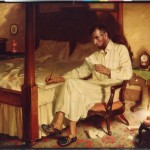 Professor Julie Oseid examines Abraham Lincoln’s writing in her article The Power of Brevity: Adopt Abraham Lincoln’s Habits, 6 J. ALWD 28 (2009). Based on her review of Lincoln’s writing, Oseid recommends that lawyers use his “habits of writing early, visualizing audience, and ruthlessly editing.” (page 29)
Professor Julie Oseid examines Abraham Lincoln’s writing in her article The Power of Brevity: Adopt Abraham Lincoln’s Habits, 6 J. ALWD 28 (2009). Based on her review of Lincoln’s writing, Oseid recommends that lawyers use his “habits of writing early, visualizing audience, and ruthlessly editing.” (page 29)
Oseid starts with the premise that “[t]he goal of brevity should be clarity.” (29) Lincoln, she says, described the opposite of brevity when he said that another lawyer could “’compress the most words into the smallest ideas of any man I ever met.’” (29) Brevity does not sacrifice precision, however, and a writer must be aware of concepts like the rhythm and sound in phrases like “’[f]our score and seven years ago.’” (30)
Brevity has persuasive power. (30) Oseid quotes Justice Antonin Scalia and Bryan A. Garner on brevity in Making Your Case: The Art of Persuading Judges: “’Judges often associate the brevity of the brief with the quality of the lawyer. Many judges we’ve spoken with say that good lawyers often come in far below the page limits—and that bad lawyers almost never do.’” (30)
 This weekend 16 law students will participate in the Jenkins Honors Moot Court Competition preliminary rounds. Two rounds will be held this Saturday at 10 a.m. and 1:00 p.m. Students will argue on-brief and off-brief. On Sunday the round begins at 10 a.m. A coin toss will determine what side students will argue. Law students are invited to attend any round of competition.
This weekend 16 law students will participate in the Jenkins Honors Moot Court Competition preliminary rounds. Two rounds will be held this Saturday at 10 a.m. and 1:00 p.m. Students will argue on-brief and off-brief. On Sunday the round begins at 10 a.m. A coin toss will determine what side students will argue. Law students are invited to attend any round of competition.
